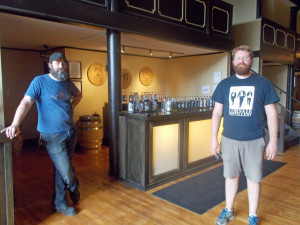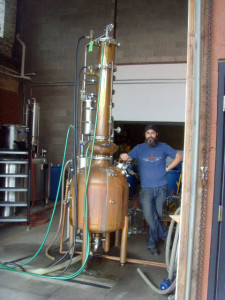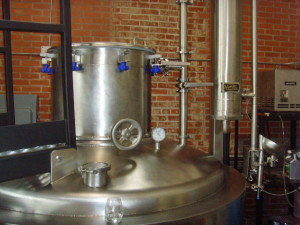Calling Copper On Corsair Distillery, Bowling Green
The Irish Rover Investigates The Stills Of Corsair’s First Plant
By Christopher Kelley
Corsair Artisan Distillery is a handcrafting, small batch distillery located in Bowling Green, Kentucky, just a few Interstate exits away from the famous Mammoth Cave National Park. This spelunker cave is one of many in the beautiful Green River Valley system, and the distillery and tasting room are a short trip from historic downtown Bowling Green, where you will find the friendliest people in the South. For me, the drive into town was as pleasant and as easy as the tasty items served there.
There are more reasons to visit Corsair than just alcohol, because the building itself is a piece of art. When I called on the distillery in July 2015, I was taken back by the size of the building. I immediately thought that these guys are doing some big things in there if they need such a big building. I entered to find a huge reception area with amazing atmosphere. The wood floors, the ornate wood trim, stairs, and bar all added to the experience.

(Credit: Christopher Kelley)
I promptly snuck up on Clay Smith and asked for a tour! Clay is the Head Distiller in Bowling Green, and he was more than receptive to my intrusion. Before we began, I told him that I was there to do an interview from a distilling equipment builders point of view and that I wanted to do a different twist to my articles. I explained that I was tired of the run of the mill reviews and pretty photos in all the other magazines, and that I wanted the raw stuff. In order for craft distilleries to grow there is a need for greater disclosure, to tell the public why they should want to drink your product rather that pull a major name brand off the shelf.
So, when I asked Clay if he was the Master Distiller, he replied, “I am the Head Distiller!” He made the distinction quite clear that a Master Distiller can tell you everything about the distilling process, and his goal is to grow into that title.
Clay went on, “The advertising Industry drives the term Master Distiller as a cliché to impress the general public for anyone in charge of the distilling process.” In reality, many of the craft distillers are just following the procedures taught to them by their predecessors, who may not have understood the science behind distilling, but had a firm grasp on what processes yielded the desired result. Alcohol brewing and distilling is an art and this process is steeped in tradition.
Where the real science behind Corsairs comes into play is in their variety of flavors offered in many forms. These guys are not just making white dog, but are also experimenting with several projects so as to expand their customer base. Darek Bell, the owner, often says Corsair experiments with up to 100 mashbills every year, looking for new products. Western Kentucky University is just a hop, skip, and jump away, and Corsair also has a distillery in Nashville, so it would be foolish not to cater to the local customer base with a variety of alcohols, so anyone can find their favorite.

(Credit: Christopher Kelley)
Let’s talk stills! Corsair’s mainstay still is a spherical Vendome 50 gallon copper still with multiple plates, four site glasses, and a dephlegmator. The heat source is an oil-fired heat exchange pump that can warm up the internal half inch diameter coil in just half an hour. The thermal oil heat source is very safe and affordable to run. The oil transfer system is under low pressure and probably safer than a steam system, not to mention cheap to run.
This finish-still is a wonderful piece of art regardless of its size. Clay explained the entire distilling process of his current whiskey run and stated that most of the time they just use a couple of the plates in the column to retain more flavor. Instead of stripping the alcohol more and adding water back into the finish, they go for the lower alcohol proof finish in favor of showcasing the grain notes. Clay also mentioned he rarely ever uses the dephlegmator in his runs because he feels it strips too much of the grain note flavor.
The stripping still “Cartman” is also a short and fat Vendome still, but this hefty boy is quite different from the finish still in many ways. This big fella is 175 gallons worth of stainless steel, and is heated with an outer jacket oil bath. That bath is heated by four 3-phase elements, and is under no pressure. This still has the ability to produce a true distilled gin from a grain slurry with no need for adding flavor after the finish run. The 24-inch Tarter head is equipped with a four section removable basket, giving it versatility to do many alcohols and the ability to add flavor the product with botanicals. Since they are using Cartman as a stripping still, it was wise to save cost by buying a stainless unit. Economics plays a big part in survival in the craft distiller world, and this particular still was half the cost of copper and at twice the size.

(Credit: Christopher Kelley)
During the gin distilling process the tails play an important part in his finished product, and even then he utilizes the dephlegmator only if needed. Since we are on the subject of Gin let us talk about that process with these particular stills. Clay first makes his 300 gallons of beer, then distills 100 gallons worth of low wine in “Cartman.” Two full fifty gallon runs in, Papa Smurf finishes the job for around 20 to 25 gallons of heaven in a bottle.
Onto condensers! Papa Smurf’s condenser is a one half inch copper worm in a cool water bath setting inside a stainless steel can. Clay and I both agree that a Gatling gun condenser is our favorite means of cooling the alcohol vapors due to the design of being very efficient and easily cleaned in a citric acid bath, but nothing is as cool and recognizable as the copper worm. If you show anyone a cylindrical vessel with a copper worm spinning away from it, they automatically assume it is a still. This little guy puts out 5 to 6 gallons of hearts and runs just a few hours, with the ability to raise the heat quickly without scorching particulates of the grains.
There were a few technical things we didn’t agree upon, each of us having our own views. I queried about the thickness of the copper and all the overkill on site glasses and multiple stainless steel clamps. My theory is that you are wasting time and money heating all that stuff up. Their still could take a nuclear blast, but one made with thinner copper while keeping the tensile strength to more than resist the pressure exerted upon it would be far more efficient.
The longer the still runs and the higher the temperature it takes to get it up there makes a drastic difference. A 50-gallon still built with 14 gauge sides and a 12 gauge bottom* is enough strength to survive a small skirmish, at least. Clay’s rebuttal was the heavier metal ensured the safety for his visitors, who are able to stand within a few feet of a running still. Other reasons were for aesthetic value.
Craft distilling is often old school, and Corsair’s signature alcohols are heads and tails above the most common types of, gin, vodka, rum, and, of course, whiskey. And for both the whiskey and the distillery, if their goal was to impress an intimate experience with the craft connoisseur, then I say they have achieved the ultimate goal!
*Birmingham Scale Measurement




Thanks for publishing my works, you guys rock!